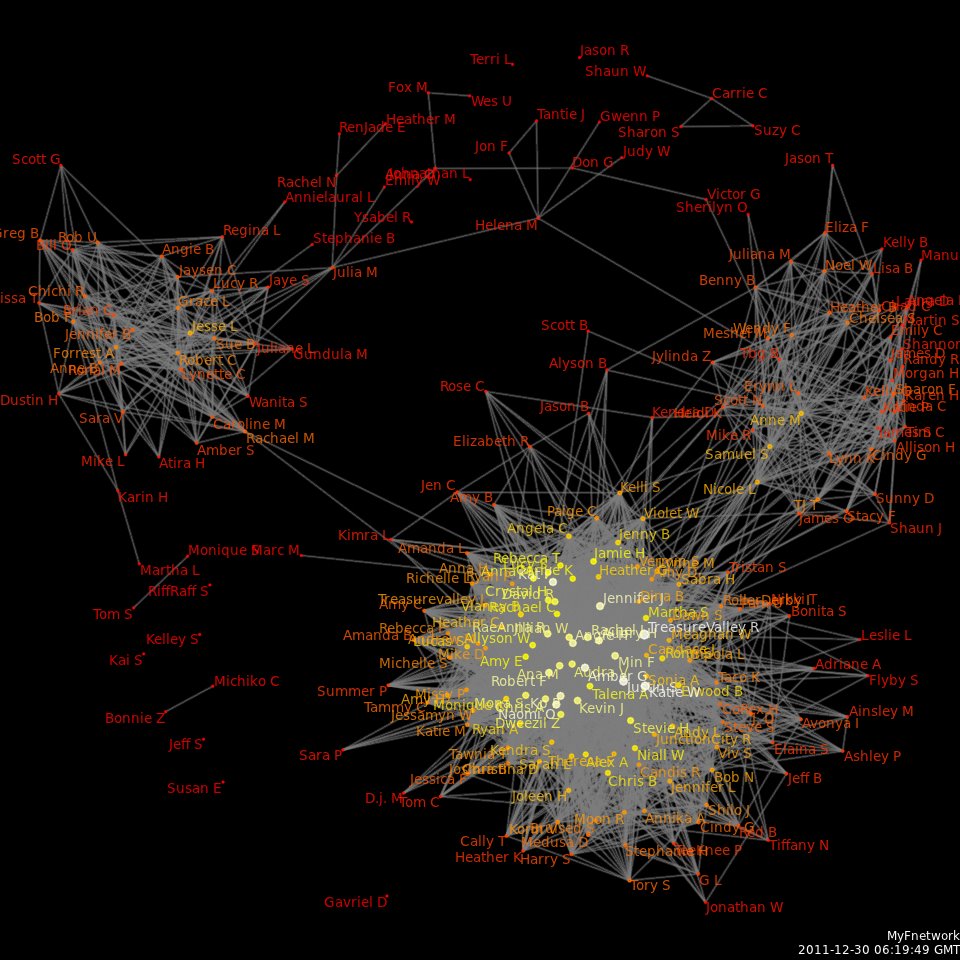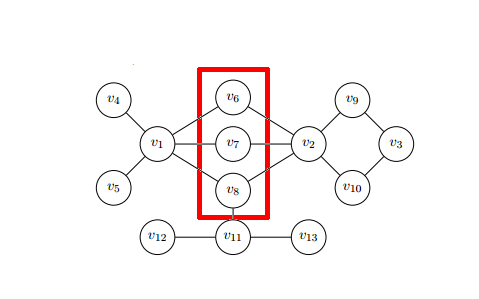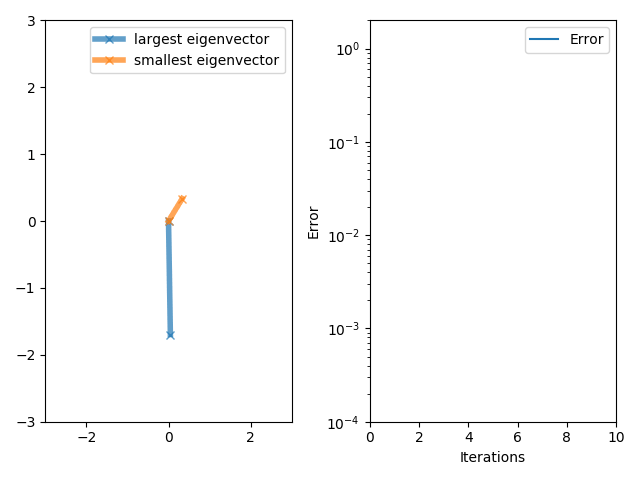|
Alpha Centrality
In graph theory and social network analysis, alpha centrality is an alternative name for Katz centrality. It is a measure of centrality of nodes within a graph. It is an adaptation of eigenvector centrality with the addition that nodes are imbued with importance from external sources. Definition Given a graph with adjacency matrix A_, Katz centrality is defined as follows: : \vec = (I-\alpha A^T)^\vec - \vec \, where e_j is the external importance given to node j, and \alpha is a nonnegative attenuation factor which must be smaller than the inverse of the spectral radius of A. The original definition by Katz used a constant vector \vec. Hubbell introduced the usage of a general \vec. Half a century later, Bonacich and Lloyd defined alpha centrality as : \vec = (I-\alpha A^T)^\vec \, which is essentially identical to Katz centrality. More precisely, the score of a node j differs exactly by e_j, so if \vec is constant the order induced on the nodes is identical. Motivation ... [...More Info...] [...Related Items...] OR: [Wikipedia] [Google] [Baidu] |
Graph Theory
In mathematics, graph theory is the study of ''graphs'', which are mathematical structures used to model pairwise relations between objects. A graph in this context is made up of '' vertices'' (also called ''nodes'' or ''points'') which are connected by '' edges'' (also called ''links'' or ''lines''). A distinction is made between undirected graphs, where edges link two vertices symmetrically, and directed graphs, where edges link two vertices asymmetrically. Graphs are one of the principal objects of study in discrete mathematics. Definitions Definitions in graph theory vary. The following are some of the more basic ways of defining graphs and related mathematical structures. Graph In one restricted but very common sense of the term, a graph is an ordered pair G=(V,E) comprising: * V, a set of vertices (also called nodes or points); * E \subseteq \, a set of edges (also called links or lines), which are unordered pairs of vertices (that is, an edge is associated with t ... [...More Info...] [...Related Items...] OR: [Wikipedia] [Google] [Baidu] |
Social Network Analysis
Social network analysis (SNA) is the process of investigating social structures through the use of networks and graph theory. It characterizes networked structures in terms of ''nodes'' (individual actors, people, or things within the network) and the ''ties'', ''edges'', or ''links'' (relationships or interactions) that connect them. Examples of social structures commonly visualized through social network analysis include social media networks, memes spread, information circulation, friendship and acquaintance networks, business networks, knowledge networks, difficult working relationships, social networks, collaboration graphs, kinship, disease transmission, and sexual relationships. These networks are often visualized through ''sociograms'' in which nodes are represented as points and ties are represented as lines. These visualizations provide a means of qualitatively assessing networks by varying the visual representation of their nodes and edges to reflect attributes of in ... [...More Info...] [...Related Items...] OR: [Wikipedia] [Google] [Baidu] |
Katz Centrality
In graph theory, the Katz centrality of a node is a measure of centrality in a network. It was introduced by Leo Katz in 1953 and is used to measure the relative degree of influence of an actor (or node) within a social network. Unlike typical centrality measures which consider only the shortest path (the geodesic) between a pair of actors, Katz centrality measures influence by taking into account the total number of walks between a pair of actors. It is similar to Google's PageRank and to the eigenvector centrality. Measurement Katz centrality computes the relative influence of a node within a network by measuring the number of the immediate neighbors (first degree nodes) and also all other nodes in the network that connect to the node under consideration through these immediate neighbors. Connections made with distant neighbors are, however, penalized by an attenuation factor \alpha. Each path or connection between a pair of nodes is assigned a weight determined by \alpha and ... [...More Info...] [...Related Items...] OR: [Wikipedia] [Google] [Baidu] |
Centrality
In graph theory and network analysis, indicators of centrality assign numbers or rankings to nodes within a graph corresponding to their network position. Applications include identifying the most influential person(s) in a social network, key infrastructure nodes in the Internet or urban networks, super-spreaders of disease, and brain networks. Centrality concepts were first developed in social network analysis, and many of the terms used to measure centrality reflect their sociological origin.Newman, M.E.J. 2010. ''Networks: An Introduction.'' Oxford, UK: Oxford University Press. Definition and characterization of centrality indices Centrality indices are answers to the question "What characterizes an important vertex?" The answer is given in terms of a real-valued function on the vertices of a graph, where the values produced are expected to provide a ranking which identifies the most important nodes. The word "importance" has a wide number of meanings, leading to many diffe ... [...More Info...] [...Related Items...] OR: [Wikipedia] [Google] [Baidu] |
Graph (discrete Mathematics)
In discrete mathematics, and more specifically in graph theory, a graph is a structure amounting to a Set (mathematics), set of objects in which some pairs of the objects are in some sense "related". The objects correspond to mathematical abstractions called ''Vertex (graph theory), vertices'' (also called ''nodes'' or ''points'') and each of the related pairs of vertices is called an ''edge'' (also called ''link'' or ''line''). Typically, a graph is depicted in diagrammatic form as a set of dots or circles for the vertices, joined by lines or curves for the edges. Graphs are one of the objects of study in discrete mathematics. The edges may be directed or undirected. For example, if the vertices represent people at a party, and there is an edge between two people if they shake hands, then this graph is undirected because any person ''A'' can shake hands with a person ''B'' only if ''B'' also shakes hands with ''A''. In contrast, if an edge from a person ''A'' to a person ''B'' m ... [...More Info...] [...Related Items...] OR: [Wikipedia] [Google] [Baidu] |
Eigenvector Centrality
In graph theory, eigenvector centrality (also called eigencentrality or prestige score) is a measure of the influence of a node in a network. Relative scores are assigned to all nodes in the network based on the concept that connections to high-scoring nodes contribute more to the score of the node in question than equal connections to low-scoring nodes. A high eigenvector score means that a node is connected to many nodes who themselves have high scores. Google's PageRank and the Katz centrality are variants of the eigenvector centrality. Using the adjacency matrix to find eigenvector centrality For a given graph G:=(V,E) with , V, vertices let A = (a_) be the adjacency matrix, i.e. a_ = 1 if vertex v is linked to vertex t, and a_ = 0 otherwise. The relative centrality score, x_v, of vertex v can be defined as: : x_v = \frac 1 \lambda \sum_ x_t = \frac 1 \lambda \sum_ a_ x_t where M(v) is the set of neighbors of v and \lambda is a constant. With a small rearrangement this c ... [...More Info...] [...Related Items...] OR: [Wikipedia] [Google] [Baidu] |
Adjacency Matrix
In graph theory and computer science, an adjacency matrix is a square matrix used to represent a finite graph. The elements of the matrix indicate whether pairs of vertices are adjacent or not in the graph. In the special case of a finite simple graph, the adjacency matrix is a (0,1)-matrix with zeros on its diagonal. If the graph is undirected (i.e. all of its edges are bidirectional), the adjacency matrix is symmetric. The relationship between a graph and the eigenvalues and eigenvectors of its adjacency matrix is studied in spectral graph theory. The adjacency matrix of a graph should be distinguished from its incidence matrix, a different matrix representation whose elements indicate whether vertex–edge pairs are incident or not, and its degree matrix, which contains information about the degree of each vertex. Definition For a simple graph with vertex set , the adjacency matrix is a square matrix such that its element is one when there is an edge from vertex to ... [...More Info...] [...Related Items...] OR: [Wikipedia] [Google] [Baidu] |
Spectral Radius
In mathematics, the spectral radius of a square matrix is the maximum of the absolute values of its eigenvalues. More generally, the spectral radius of a bounded linear operator is the supremum of the absolute values of the elements of its spectrum. The spectral radius is often denoted by . Definition Matrices Let be the eigenvalues of a matrix . The spectral radius of is defined as :\rho(A) = \max \left \. The spectral radius can be thought of as an infimum of all norms of a matrix. Indeed, on the one hand, \rho(A) \leqslant \, A\, for every natural matrix norm \, \cdot\, ; and on the other hand, Gelfand's formula states that \rho(A) = \lim_ \, A^k\, ^ . Both of these results are shown below. However, the spectral radius does not necessarily satisfy \, A\mathbf\, \leqslant \rho(A) \, \mathbf\, for arbitrary vectors \mathbf \in \mathbb^n . To see why, let r > 1 be arbitrary and consider the matrix : C_r = \begin 0 & r^ \\ r & 0 \end . The characteristic polynomial ... [...More Info...] [...Related Items...] OR: [Wikipedia] [Google] [Baidu] |
Power Method
In mathematics, power iteration (also known as the power method) is an eigenvalue algorithm: given a diagonalizable matrix A, the algorithm will produce a number \lambda, which is the greatest (in absolute value) eigenvalue of A, and a nonzero vector v, which is a corresponding eigenvector of \lambda, that is, Av = \lambda v. The algorithm is also known as the Von Mises iteration.Richard von Mises and H. Pollaczek-Geiringer, ''Praktische Verfahren der Gleichungsauflösung'', ZAMM - Zeitschrift für Angewandte Mathematik und Mechanik 9, 152-164 (1929). Power iteration is a very simple algorithm, but it may converge slowly. The most time-consuming operation of the algorithm is the multiplication of matrix A by a vector, so it is effective for a very large sparse matrix with appropriate implementation. The method The power iteration algorithm starts with a vector b_0, which may be an approximation to the dominant eigenvector or a random vector. The method is described by the recurre ... [...More Info...] [...Related Items...] OR: [Wikipedia] [Google] [Baidu] |
Algebraic Graph Theory
Algebraic graph theory is a branch of mathematics in which algebraic methods are applied to problems about graphs. This is in contrast to geometric, combinatoric, or algorithmic approaches. There are three main branches of algebraic graph theory, involving the use of linear algebra, the use of group theory, and the study of graph invariants. Branches of algebraic graph theory Using linear algebra The first branch of algebraic graph theory involves the study of graphs in connection with linear algebra. Especially, it studies the spectrum of the adjacency matrix, or the Laplacian matrix of a graph (this part of algebraic graph theory is also called spectral graph theory). For the Petersen graph, for example, the spectrum of the adjacency matrix is (−2, −2, −2, −2, 1, 1, 1, 1, 1, 3). Several theorems relate properties of the spectrum to other graph properties. As a simple example, a connected graph with diameter ''D'' w ... [...More Info...] [...Related Items...] OR: [Wikipedia] [Google] [Baidu] |
Social Network Analysis
Social network analysis (SNA) is the process of investigating social structures through the use of networks and graph theory. It characterizes networked structures in terms of ''nodes'' (individual actors, people, or things within the network) and the ''ties'', ''edges'', or ''links'' (relationships or interactions) that connect them. Examples of social structures commonly visualized through social network analysis include social media networks, memes spread, information circulation, friendship and acquaintance networks, business networks, knowledge networks, difficult working relationships, social networks, collaboration graphs, kinship, disease transmission, and sexual relationships. These networks are often visualized through ''sociograms'' in which nodes are represented as points and ties are represented as lines. These visualizations provide a means of qualitatively assessing networks by varying the visual representation of their nodes and edges to reflect attributes of in ... [...More Info...] [...Related Items...] OR: [Wikipedia] [Google] [Baidu] |



